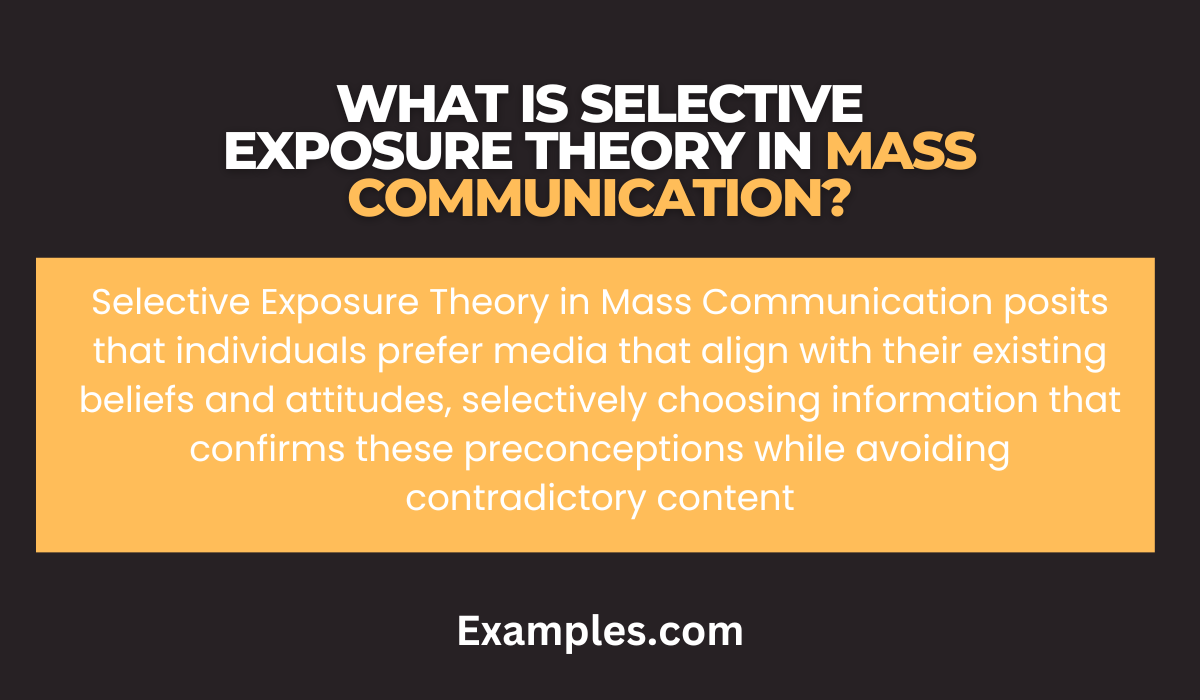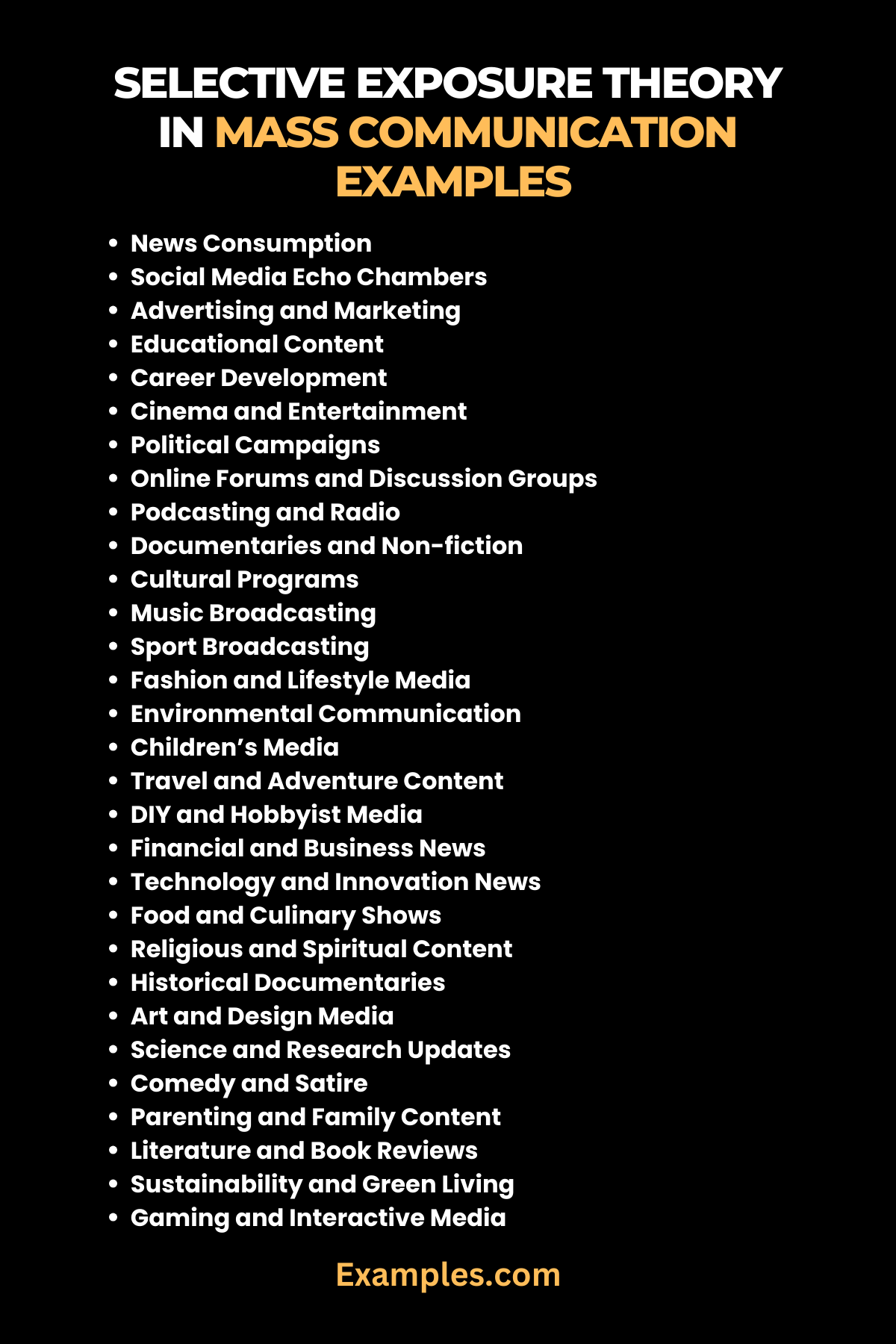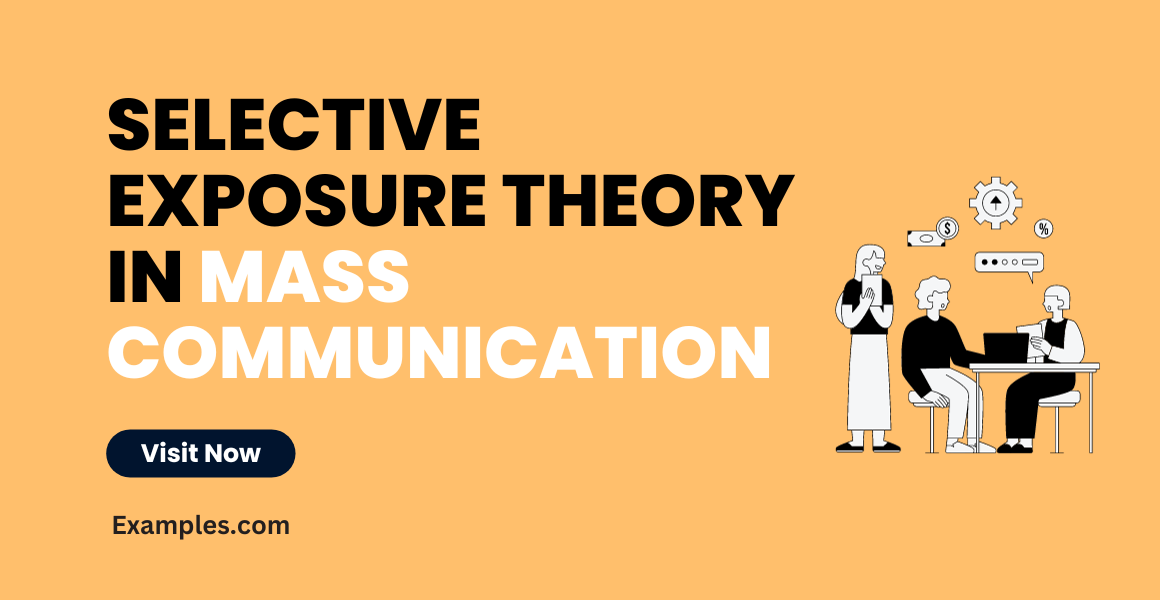29+ Selective Exposure Theory in Mass Communication Examples
Dive into the world of Selective Exposure Theory in Mass Communication, a crucial concept for understanding audience behavior in the digital era. This comprehensive guide unpacks how individuals selectively choose media messages that align with their pre-existing beliefs and attitudes. It’s an essential read for those exploring Mass Communication Theories and the Uses & Benefits of Mass Communication. Whether it’s analyzing Social Media Mass Communication trends or studying Mass Communication in Broadcasting, understanding selective exposure is key to grasping how audiences interact with media today. This guide offers insightful perspectives for students, professionals, and anyone keen on decoding the complexities of audience-media relationships in mass communication.
What is Selective Exposure Theory in Mass Communication?
Selective Exposure Theory in Mass Communication is a concept that addresses how individuals favor media messages and content that align with their pre-existing beliefs and attitudes. This theory suggests that people actively choose to expose themselves to media that confirms their viewpoints, while avoiding contradictory information. This behavior reflects a natural tendency to seek comfort in familiar and agreeable information, thus maintaining one’s existing perspective.

History of Selective Exposure Theory in Mass Communication
The concept of selective exposure in mass communication dates back to the early 20th century, with roots in psychology and sociology. Initially, it was believed that mass media had a powerful and direct impact on the public, as per the Hypodermic Needle Theory. However, as media studies evolved, it became evident that audiences are not passive recipients. The selective exposure theory gained prominence, highlighting that individuals’ choices in media consumption are influenced by their existing beliefs and biases. This shift marked a significant development in understanding the complex relationship between media and its audience.
What is the Best Example of Selective Exposure Theory in Mass Communication?
A prime example of selective exposure in mass communication can be observed in the realm of political news consumption. People often choose news sources that reflect their political affiliations, reinforcing their pre-existing beliefs. For instance, a conservative individual might prefer watching a news channel known for its right-leaning content, while a liberal might choose a channel with a left-leaning bias. This behavior limits exposure to diverse viewpoints and can lead to an echo chamber effect, where one’s beliefs are constantly reinforced without being challenged.
In summary, selective exposure theory plays a crucial role in shaping our understanding of media consumption. It highlights the selective nature of audiences in a world abundant with media choices. This understanding is vital for professionals in mass communication jobs/careers, such as journalists, public relations specialists, and media researchers, as it influences how they craft and disseminate information to reach diverse audiences effectively.

30 Examples of Selective Exposure Theory in Mass Communication
Selective Exposure Theory in Mass Communication is a pivotal concept illustrating how individuals preferentially choose media messages aligning with their pre-existing beliefs and values. This phenomenon significantly impacts Mass Communication Examples and Mass Communication Characteristics, shaping the landscape of media consumption and production.

1. News Consumption: A prime example is in news media, where individuals often select news sources that mirror their political or social viewpoints. For instance, a conservative might prefer news from a channel known for right-leaning content, while a liberal might choose a source with left-leaning perspectives. This selective exposure influences the public’s perception of events, contributing to a polarized society.
2. Social Media Echo Chambers: In the realm of Social Media Mass Communication, selective exposure is evident through algorithms that feed users content similar to what they’ve previously liked or interacted with. This creates ‘echo chambers’, where one is exposed only to viewpoints similar to their own, reinforcing existing beliefs and potentially limiting exposure to diverse perspectives.
3. Advertising and Marketing: Selective exposure theory also plays a significant role in advertising. Marketers often target audiences based on their known preferences, ensuring that their message reaches those most likely to be receptive. This targeted approach maximizes the impact of advertising campaigns and is a key strategy in Mass Communication in Advertising.
4. Educational Content: In educational settings, selective exposure can be observed when students or educators gravitate towards materials that confirm their educational philosophies or teaching methods. This phenomenon is particularly relevant in Mass Communication Examples in School, where curriculum choices may reflect the selective exposure preferences of educators.
5. Career Development: In the context of Mass Communication Jobs/Careers, understanding selective exposure helps professionals tailor their messages to specific audiences more effectively. For example, a public relations specialist might use this theory to craft messages that resonate with a target demographic, increasing the effectiveness of communication strategies.
6. Cinema and Entertainment: In the film and entertainment industry, selective exposure theory explains why certain genres or styles become popular among specific groups. Audiences often choose movies or TV shows that reflect their tastes and values, influencing the types of content that are produced and successful.
7. Political Campaigns: Political campaigns utilize selective exposure theory by targeting messages that resonate with their base while attempting to sway undecided voters. This strategic communication is essential in shaping public opinion and electoral outcomes.
8. Online Forums and Discussion Groups: In online communities, selective exposure often leads to the formation of niche groups where members share similar interests and viewpoints, reinforcing their pre-existing beliefs and potentially limiting exposure to alternative perspectives.
9. Podcasting and Radio: In the realm of podcasting and radio broadcasting, hosts and producers often cater to specific audience segments, knowing that listeners selectively choose content that aligns with their interests and beliefs.
10. Documentaries and Non-fiction: Documentary filmmakers often leverage selective exposure by creating content that appeals to viewers with specific interests or viewpoints, ensuring a dedicated audience for their work.
11.Cultural Programs: Cultural programming on television or online platforms illustrates selective exposure, as viewers choose programs that resonate with their cultural background or interests, influencing the diversity and representation in media.
12. Music Broadcasting: In music radio and streaming services, listeners’ preferences guide the type of music played, demonstrating selective exposure in the selection of genres and artists that align with their taste.
13. Sport Broadcasting: Fans of specific sports or teams exhibit selective exposure by primarily following media coverage related to their preferred sports or teams, impacting sports journalism and broadcasting strategies.
14. Fashion and Lifestyle Media: In fashion and lifestyle sectors, consumers selectively engage with media that reflects their style and life philosophy, influencing trends and marketing in these industries.
15. Environmental Communication: Environmental advocates and skeptics often consume media that reinforces their views on environmental issues, demonstrating selective exposure in environmental journalism and advocacy.
16. Children’s Media: Selective exposure is evident in children’s media choices, often influenced by their interests and developmental stage, guiding content creation for children’s programming.
17. Travel and Adventure Content: Travel enthusiasts exhibit selective exposure by engaging with content related to destinations and activities of interest, influencing travel journalism and content creation.
18. DIY and Hobbyist Media: In DIY and hobbyist communities, individuals often consume media that aligns with their specific hobbies or interests, shaping content creation in these niches.
19. Financial and Business News: Investors and business professionals show selective exposure in their consumption of financial news and information, impacting financial journalism and media strategies
20. Technology and Innovation News: Tech enthusiasts demonstrate selective exposure by following media outlets that focus on the latest technology and innovations, influencing tech journalism and content creation.
21. Food and Culinary Shows: Food enthusiasts selectively engage with culinary shows and content that align with their dietary preferences or culinary interests, shaping the production of food-related media.
22. Religious and Spiritual Content: Individuals often seek religious or spiritual content that aligns with their beliefs, impacting how religious and spiritual themes are presented in mass media.
23. Historical Documentaries: History buffs show selective exposure by choosing documentaries and content related to specific historical periods or events of interest, influencing historical media production.
24. Art and Design Media: Art enthusiasts and professionals selectively consume media related to their specific art interests or fields, impacting art and design journalism and content.
25. Science and Research Updates: Individuals interested in science and research tend to follow media outlets that provide updates in specific scientific fields, influencing science communication and media strategies.
26. Comedy and Satire: Fans of comedy and satire exhibit selective exposure by choosing content that aligns with their sense of humor and satirical preferences, impacting comedy programming and production.
27. Parenting and Family Content: Parents often seek media content related to parenting styles and family life that resonate with their personal experiences and values, influencing family-oriented media.
28. Literature and Book Reviews: Book lovers show selective exposure by engaging with media content about specific genres or authors they prefer, impacting literary journalism and book-related media.
29. Sustainability and Green Living: Individuals interested in sustainability and eco-friendly living selectively consume media that focuses on these themes, influencing environmental journalism and content creation.
30. Gaming and Interactive Media: Gamers exhibit selective exposure by engaging with content related to their preferred gaming genres or platforms, influencing the creation and marketing of gaming media and interactive content.
Role of Selective Exposure Theory in Mass Communication
- Influence on Audience Behavior: Selective Exposure Theory explains why audiences gravitate towards certain types of content. In mass communication, this understanding helps in crafting messages that resonate with the target audience, enhancing engagement and retention.
- Impact on News Consumption: In Journalism Mass Communication, this theory is critical. It elucidates why people choose specific news sources that echo their political or social views, shaping public opinion and discourse.
- Advertising and Marketing Strategies: In the context of Mass Communication in Advertising, Selective Exposure Theory assists advertisers in designing campaigns that align with the beliefs and preferences of their target demographic, thereby increasing the effectiveness of their advertising efforts.
- Content Creation and Distribution: Understanding this theory aids content creators and distributors in tailoring their content to meet the selective preferences of different audience segments, be it in Television Mass Communication, Social Media Mass Communication, or Blog Mass Communication.
- Educational Implications: In academic settings, such as Mass Communication Examples in School, this theory guides the development of curricula and teaching methodologies that align with students’ interests and learning preferences.
- Media Planning and Development: In the broader scope of Mass Communication Jobs/Careers, professionals use this theory to develop media plans and communication strategies that effectively reach and influence target audiences.
- Digital Media Trends: With the advent of digital platforms, Mass Communication Examples in a Digital Age have shown how selective exposure influences the spread and reception of digital content, affecting everything from viral marketing campaigns to online news consumption.
- Cultural and Social Implications: This theory also plays a significant role in understanding the cultural and social dynamics of media consumption, particularly in how media shapes and is shaped by societal norms and values.
- Impact on Public Opinion Formation: In Public Relations Mass Communication, selective exposure theory helps in understanding how public opinions are formed and manipulated, aiding in the development of more effective public relations strategies.
- Enhancing Audience Engagement: By leveraging the principles of Selective Exposure Theory, mass communication professionals can enhance audience engagement and participation, crucial in areas like Broadcasting Mass Communication and Email Mass Communication.
- Addressing Media Bias: This theory is instrumental in addressing issues of media bias and propaganda, offering insights into how and why certain narratives gain traction over others in the media landscape.
Importance of Selective Exposure Theory in Mass Communication
- Personalized Content Consumption: Selective Exposure Theory helps explain why audiences prefer certain mass communication examples in media that align with their personal beliefs and values. This personalized consumption pattern is crucial for media producers and advertisers to understand in order to tailor their content and marketing strategies effectively.
- Reinforcement of Beliefs and Attitudes: By choosing media content that aligns with their existing beliefs, audiences reinforce these beliefs, making the theory essential in understanding the role of mass media in shaping public opinion and attitudes.
- Impact on Political and Social Polarization: This theory is instrumental in explaining the increasing political and social polarization observed in society. It suggests that exposure to selective media content can deepen divides in public opinion.
- Influence on Media Planning and Strategy: Understanding Selective Exposure Theory is critical for professionals in mass communication jobs/careers who are responsible for media planning and content strategy. It guides them in creating content that resonates with their target audience while also challenging them to present diverse viewpoints.
- Educational Implications: In educational settings, particularly those focusing on mass communication, this theory can be used to teach students about the importance of being exposed to a variety of perspectives to develop a well-rounded understanding of different issues.
- Role in Public Relations and Advertising: For public relations and advertising professionals, Selective Exposure Theory underscores the importance of crafting messages that not only attract the target audience but also challenge them to engage with different viewpoints.
- Digital Media and Selective Exposure: With the advent of digital media, this theory becomes even more significant. Algorithms on social media and news platforms often cater to users’ preferences, leading to a filtered bubble of information that can further reinforce selective exposure.
- Enhancing Media Literacy: Understanding this theory is crucial in enhancing media literacy among audiences. It encourages critical thinking and awareness about the content they consume and the potential biases it may include.
- Implications for Democracy and Public Discourse: Selective Exposure Theory has profound implications for democracy and public discourse. It emphasizes the need for diverse and balanced media consumption to ensure a well-informed public capable of engaging in democratic processes effectively.
- Future Research and Studies: The theory opens avenues for future research in understanding evolving media consumption patterns, especially in the digital age where content customization and targeted advertising are prevalent.
How to Use Selective Exposure Theory in Mass Communication
To effectively use Selective Exposure Theory in Mass Communication, professionals need to adopt a multi-faceted approach:
- Audience Analysis: Conduct thorough research to understand the beliefs, preferences, and media consumption habits of your target audience. This analysis is particularly crucial in fields like Journalism Mass Communication and Advertising Mass Communication, where reaching and influencing a specific audience is key.
- Content Tailoring: Develop content that resonates with the audience’s beliefs and preferences. This does not mean reinforcing stereotypes or biases but rather understanding the audience’s perspective and crafting messages that they can relate to.
- Diverse Media Channels: Utilize a variety of media channels to reach different audience segments. For example, Email Mass Communication might be more effective for a professional audience, while Social Media Mass Communication could be better suited for younger demographics.
- Feedback Mechanisms: Implement feedback systems to understand how your audience is receiving and perceiving your content. This feedback is essential in refining strategies and ensuring that the content remains relevant and engaging.
Selective Exposure Theory highlights how media consumption is influenced by personal beliefs, shaping communication strategies and content creation across various mass communication platforms and industries.



